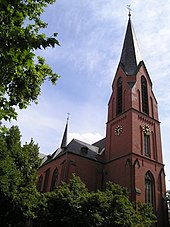St. Cäcilia (Düsseldorf-Benrath)
The Catholic parish church of St. Cäcilia in Düsseldorf-Benrath is a three - aisled neo - Gothic church with a tower attached to the side, which was built by the architect Wilhelm Sültenfuß in the late 19th century . Earlier church buildings at the same location can be traced back to 1005. The parish of the same name and the Herz-Jesu parish in Urdenbach form the parish association of Benrath-Urdenbach.
history
When the previous church was demolished, a stone was found bearing the inscription: "This choir was built in the year of the Lord 1005". A church in Benrath was first mentioned in 1250. It was a Romanesque church that belonged to the Neuss deanery .
From 1609 to 1616 this church was a Reformed Church , after which it became Catholic again.
In 1824 a second church was built. However, this church was no longer sufficient due to the growing population in the course of industrialization towards the end of the 19th century. In 1899 Wilhelm Sültenfuß was commissioned to build a larger church using the existing space. The foundation stone was laid in 1901; In 1902 the old church was torn down except for the tower; the tower stopped. In 1903 the new church was consecrated.
organ
The first organ was built in 1908 by the organ building company Fabritius (Düsseldorf). The instrument had 24 registers on two manuals and pedal and pneumatic action . In 1976 the organ building company Seifert (Kevelaer) redesigned the instrument according to neo-baroque sound concepts; In particular, a Rückpositiv was added, and several basic voices were replaced by mixtures and individual aliquots.
In 2006 and 2007 the instrument was reorganized by Orgelbau Schumacher (Eupen, Belgium). The neo-baroque voices were concentrated in the Rückpositiv, a new disposition was developed for the Schwellwerk and the Hauptwerk that corresponds to the original concept. Some neo-baroque registers were given up in favor of basic voices, three new reed parts were added, the case of the Rückpositiv was optically adapted to the neo-Gothic case. The instrument has 33 registers on three manuals and a pedal.
|
|
|
|
|||||||||||||||||||||||||||||||||||||||||||||||||||||||||||||||||||||||||||||||||||||||||||||||||||||||||||||||||||||||||||||
-
Pairing :
- Normal coupling: II / I, III / I, III / II, I / P, II / P, III / P
- Sub-octave coupling: I / I, III / I, III / II, III / III
- annotation
- (S) = register by Schumacher (2007)
Bells
During World War I and World War II, St. Cäcilia lost its bells, which were melted down. In 1949 the church received 5 new bells, cast by Karl (III) Otto, Bell foundry F. Otto, Bremen-Hemelingender.
| No. |
patron |
Diameter (mm) |
Weight (kg) |
Nominal |
inscription |
|---|---|---|---|---|---|
| 1 | Christ the King | 1540 | 2300 | c 1 ± 0 | "CHRIST THE KING OF ETERNALITIES, I WANT TO SINGING PRAISES AT ALL TIMES" |
| 2 | Maria | 1290 | 1350 | it 1 +2 | "KEEP WOMEN COURSE AND BREEDING, MEN BELIEVE AND TUG'D." |
| 3 | Joseph | 1150 | 1000 | f 1 +2 | THANKS TO SAINT JOSEF FOR KEEPING THE CHURCH (1939-1945)! "ST. JOSEF, FAITHFUL WORKMAN, TAKE CARE OF EVERYONE'S WORRIES; JESUS, YOUR FOSTER, ASK FOR WORK AND RIGHT PAY." |
| 4th | Cecilia | 1030 | 700 | g 1 +1 | HOLY CÄCILIA, PATRONESS OF OUR PARISH, WITH YOU WE ASK: "LET MY HEART REMAIN IMPECCABLE, DO NOT LET ME BE DISAPPEARED!" |
| 5 | Jesus child | 980 | 580 | as 1 +2 | "LET THE KIDS COME TO ME!" |
"Te Deum laudamus"
Individual evidence
- ↑ St. Cäcilia Benrath.de: Geschichte ( Memento from December 6, 2013 in the Internet Archive )
- ↑ Information and disposition of the Fabritius organ from 1908
- ↑ Information about the renovation by Seifert and Disposition
- ↑ Comprehensive information on the history and disposition of the organ
- ↑ Information about the organ on the website of the organ building company Schumacher
- ↑ Information on the bells , p. 38 ff.
Web links
- History of the Church of St. Cäcilia (Catholic Church Community Association Benrath / Urdenbach)
- St. Cäcilia: Tour ( Memento from December 6, 2013 in the Internet Archive )
- Entry in the monument list of the state capital Düsseldorf at the Institute for Monument Protection and Preservation
Coordinates: 51 ° 9 ′ 47.3 " N , 6 ° 52 ′ 26.1" E
